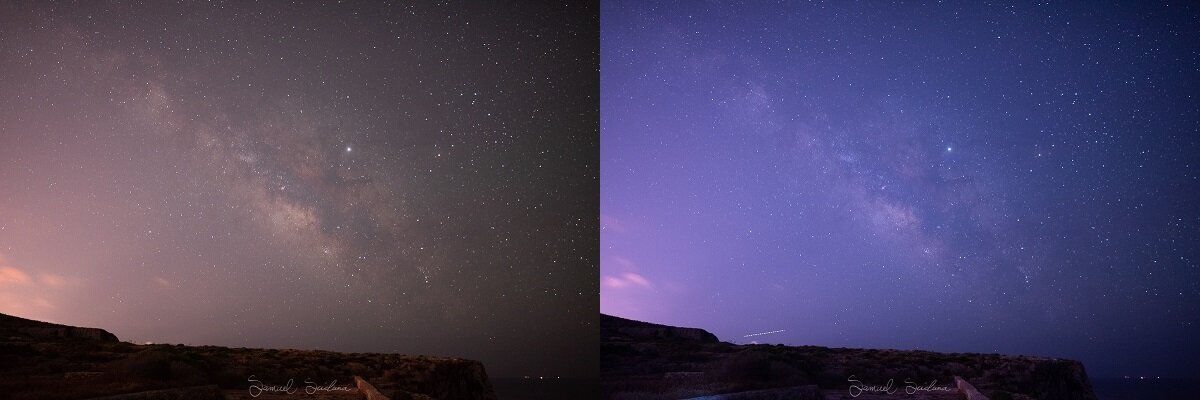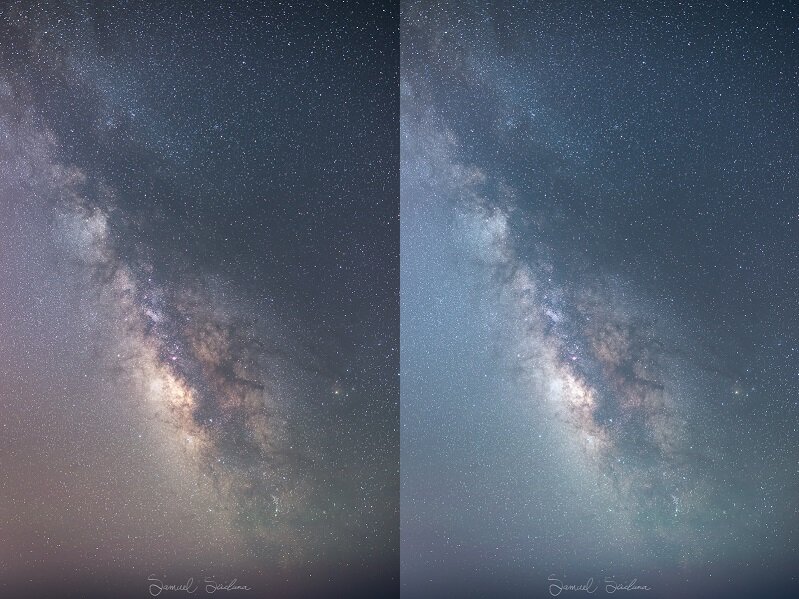What Kind Of Glass Haida Night Filter
Review - Haida Articulate-Nighttime Filter

A starry sky at Blata tal Melh in Malta, shot using the Haida Clear-Dark Filter.
Settings: 14mm / ISO6400 / 30 Seconds / F2.8
The Problem
I've been shooting night skies for several years now, mostly the 'Milkyway Season' which is the summer months hither in Malta. The unmarried biggest challenge with shooting in Malta at night, is light pollution. Malta is a tiny Isle, measuring merely 316 square Kilometers, this means that unfortunately, you tin can never get more than than a couple of Kilometers away from the nearest boondocks, and the horrible glow created past unshielded and poor lighting practices. This calorie-free spills into the night sky, this is compounded by the presence of clouds and only loftier levels of humidity, as these reflect the stray low-cal and crusade a horrible yellow glow. This glow, drowns out many stars and most of the detail of the faint objects in the nighttime heaven.
Only like in Malta, the problem of light pollution is present in most developed areas around the world, and in the past, it was just something dark sky photographers had to learn to live with, even so, with recent research and development of new filters, in that location is hope for a meliorate time to come when shooting the night sky!

The 100mm 10 100mm Haida Clear-Night Filter, notice its lavender color, designed to cut out xanthous and orangish lite.
The Solution
The solution is a 'Light Pollution Filter'. I use is the Haida Articulate-Night Filter. This simple filter helps cut through the yellow lite created past older sodium-vapor and mercury-vapor bulbs. Both these bulbs have a similar wavelength, so being able to block this wavelength of low-cal from hitting the camera sensor ensures that this lite does not impact the resulting epitome.
The Haida Clear-Night Filter doesn't but reduce the yellow glow from light pollution, it also adds a piddling contrast to the Milkyway, helping bring out the fainter details in the night heaven. When I first tested the filter, I was skeptical about the touch this filter would have on sharpness, and the fact that it effectively drops the exposure by 1 end, significant to become the aforementioned exposure as I would get without the filter, I would need to increase the ISO, resulting in more noise in the image.

The 100mm x 100mm Haida Clear-Night Filter and its box
About the Filter
The Haida Clear-Dark Filter is bachelor in square 100mm x 100mm format, foursquare 150mm ten 150mm format, circular screw-on format, rear clip in format, M15 format and also as a drop-in filter for the M10 filter holder. The version I utilize is the 100mm x 100mm square filter. The filter is fabricated from high-quality K9 optical drinking glass which is anti-reflection, scratch-resistant, and water-proof.
Like any other low-cal pollution filter, the Haida Articulate-Night Filter results in a very cool-looking, blueish/magenta epitome. This is easily corrected in post processing with white balance adjustments (Information technology is extremely important to shoot in RAW format, otherwise you volition struggle to go the white balance right in post processing).

The 100mm x 100mm Haida Clear-Dark Filter and its box
Using the Haida Clear-Night Filter
Using a 100mm filter is very easy, once the relevant adapter band and M10 filter holder are attached to my lens, I merely slide the Clear-Night Filter into the slot nearest the holder (To avoid whatever calorie-free leak).

Comparing - 2 images shot in sequence, same settings for both. Left: No Filter - Right: Haida Articulate-Nighttime Filter
Testing the Haida Clear-Dark Filter
The showtime time I tested the Haida Clear-Dark Filter was when camping with some friends at Mtahleb, one on the locations in Malta with a relatively nighttime heaven. The Milkyway was notwithstanding ascension to the S East when I began capturing it, and so the glow of low-cal pollution from the mainland was visible in the frame.

Comparison - 2 images shot in sequence, same settings for both. Left: No Filter - Right: Haida Clear-Night Filter. You tin can clearly come across the cleaner and more natural colours on the image with the Haida Articulate-Dark Filter on the correct.
Information technology was a new moon that night, and so there was no moonlight in the scene, just the glow of distant light pollution. I captured images both with and without the filter for comparison. In both images, I used the following settings: 24mm / F2 / ISO6400 / ten Seconds.
The filter definitely makes a deviation in the area of the sky where in that location was low-cal pollution. The filter is great at cut through the xanthous glow, and pretty much eradicating information technology completely from the prototype, however, the Clear-Night Filter does not reduce the luminosity (Effulgence) of the light pollution, meaning the sky yet appears brighter where there is light pollution. This can exist dealt with in post processing by concealment that areas of the sky.
I revisited the same location a calendar month later on when the core of the Milkyway was to the Southward West, with the light pollution behind me, the filter didn't have a meaning affect on the resulting image, yet it did seem to add contrast, helping bring out a lilliputian more item in the Milkyway core.
From my testing, I believe the Haida Clear-Dark filter performs at its best when shooting in the direction of a light polluted sky, where the filter helps remove the yellow hues from the glow.

The Milkyway off the coast of Malta, shot using the Haida Articulate-Dark Filter.
Settings: 24mm / ISO6400 / 10 Seconds / F1.4
Flare
The Haida Articulate-Night Filter does not add whatever additional flare when shooting shut to bright lights at night thank you to the anti-reflective Nano-Coating. The filter does assist cut through the glow of flares, making it a handy tool, even when shooting cityscapes or architecture at night.

The Milkyway above some boulders at Majjistral Park in Republic of malta, shot using the Haida Articulate-Night Filter.
Settings: 24mm / ISO6400 / ten Seconds / F2
Sharpness
From the testing I have done, I cannot see whatever reduction in sharpness in the image when using the Haida Articulate Night Filter, this is probable due to the loftier quality K9 Optical glass which is used to make these filters.
Pros
-
Removes the xanthous and color cast of older sodium-vapor and mercury-vapor street lights
-
More contrast / particular in the core of the Milkyway
-
Several options bachelor (Drop in for M10, Screw on, 100mm x100mm, 150mm x 150mm and Clip in for lens)
-
Loftier quality K9 optical glass
-
Nano-coated / Anti-reflection / Scratch-resistant
-
Well priced compared to other similar filters
-
Lightweight and doesn't accept up much infinite in your camera purse
Cons
-
Does non reduce the brightness of low-cal pollution (Only removes color cast)
-
Reduces exposure by 1 stop, then volition need to compensate with college ISO
-
Does not reduce light pollution from modern LED lights

The Milkyway rises above a boulder at Blata tal Melh in Malta, shot using the Haida Clear-Night Filter.
Settings: 14mm / ISO6400 / 25 Seconds / F2.eight
Decision
I call back the Haida Clear-Night Filter performs the best when shooting away from cities and having the glow of low-cal pollution in the frame. Information technology does a very good chore of cut out the yellow glow, helping you maintain more natural colours across the frame.
The filter results in the loss of about ane stop of calorie-free from hitting the sensor, this is a double-edged sword, as the filter helps bring out some of the finer details in the night sky, but to maintain the same exposure, you lot would besides need to increase the ISO. With modernistic cameras dealing with High ISO and so well, and the unlike techniques bachelor to reduce noise, such as stacking multiple exposures or Tracking the Milkyway for longer shutter speeds, this is non a major issue.
As expected, The Haida Clear-Dark filter does not make any difference when shooting in a true dark sky site.
I am pleased with the results of the Haida Clear-Night filter and use it most of the time when shooting Nightscapes. Considering the price and the impact it has on reducing calorie-free pollution, I would definitely recommend this filter to anyone interested in night photography.
What Kind Of Glass Haida Night Filter,
Source: https://www.samuelscicluna.com/review-haida-clear-night-filter#:~:text=The%20filter%20is%20made%20from,looking%2C%20blue%2Fmagenta%20image.
Posted by: simpkinsnocarain.blogspot.com


0 Response to "What Kind Of Glass Haida Night Filter"
Post a Comment